1410, PARKSON, 44-60 ZHONGSHAN ROAD, QINGDAO, CHINA
how to use eye bolts
What Are Eye Bolts?
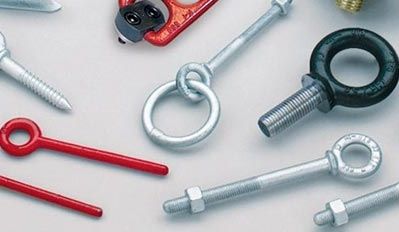 Eye bolts have a shank for anchoring to structures or equipment and a ring for attaching rope, hooks, or other hardware. They're used as anchor eye bolts for routing or tying down wire and cable. Lift eye bolts are rated for vertical lifting up to their specified capacity.
Eye bolts have a shank for anchoring to structures or equipment and a ring for attaching rope, hooks, or other hardware. They're used as anchor eye bolts for routing or tying down wire and cable. Lift eye bolts are rated for vertical lifting up to their specified capacity.
Eye bolts have a variety of uses, one of the most common being in the rigging industry, where a steel eye bolt is ideal as an anchor point for many rigging applications.
Types and Styles of Eye Bolts
The most common types of eye bolts used in industrial applications are: nut eye bolts, machinery eye bolts and screw eye bolts. All three types come in two styles: plain and shoulder. Each type comes in different sizes and finishes.
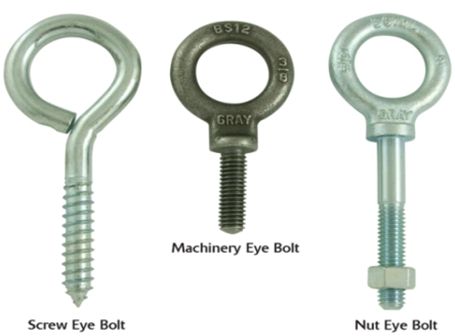
---Guidelines:
Regular rigging eyebolts should be used for straight line pulls only. For angular lifts, shoulder eye bolts are the better choice.
Always inspect a threaded eye bolt prior to use and make sure the threads and receiving holes are clean.
Never use an anchor eyebolt if the shank or eye has been bent, elongated, or deformed.
The threaded part of eye bolts must protrude through the load so the nut is allowed full engagement of threading. If an eye bolt protrudes too far through the load, you may need to shim the bolt with washers between the nut and the load prior to putting the nut on.
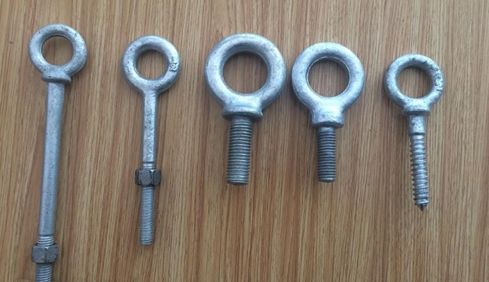
Types of eye bolts
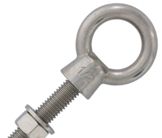 shoulder eye bolt: Marine grade stainless steel makes it supremely solid. Eye bolts with a long shoulder can be used for either straight line or angular pulls.
shoulder eye bolt: Marine grade stainless steel makes it supremely solid. Eye bolts with a long shoulder can be used for either straight line or angular pulls.
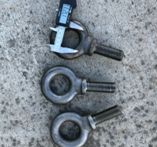 Machine eye bolt: Used as a connection point in rigging applications, this hardware eye bolt is ideal for angled lifts due to the shoulder design which offers increased strength.
Machine eye bolt: Used as a connection point in rigging applications, this hardware eye bolt is ideal for angled lifts due to the shoulder design which offers increased strength.
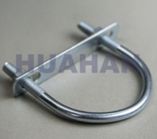 U-Bolt: Shaped with a curved base, two threaded arms offer fastening points for a secure fit. This stainless steel eyebolt is ideal for attaching pipes , rods, cords or wiring to a machine, pole, beam, etc. A cross piece insert can make it more secure in some situations.
U-Bolt: Shaped with a curved base, two threaded arms offer fastening points for a secure fit. This stainless steel eyebolt is ideal for attaching pipes , rods, cords or wiring to a machine, pole, beam, etc. A cross piece insert can make it more secure in some situations.
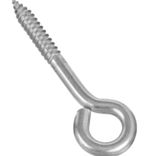 Lag eye screw: An excellent anchor point for a variety of exterior and interior uses. Stainless eye screws have a tapered yet sharp end for screwing into wood. A longer length makes them ideal when a typical eye bolt can be too short.
Lag eye screw: An excellent anchor point for a variety of exterior and interior uses. Stainless eye screws have a tapered yet sharp end for screwing into wood. A longer length makes them ideal when a typical eye bolt can be too short.
---Stainless Steel Eyebolts vs. Galvanized Eyebolts
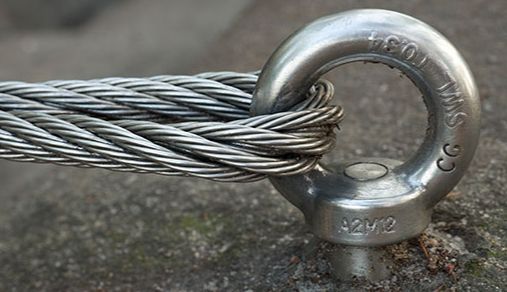 Stainless steel and galvanized metal both offer protection from rust and corrosion, making either a good choice for eye bolts and related hardware.
Stainless steel and galvanized metal both offer protection from rust and corrosion, making either a good choice for eye bolts and related hardware.
Stainless steel is an alloy of chromium and low carbon steel. Because its anti-corrosion properties are inherent, it will retain its resistance to corrosion even if the stainless steel becomes scratched so it"s an ideal eye bolt for rigging, as well as for tie down bolts, rigging eye bolts and other hardware for demanding uses. There are different grades of stainless steel, with type 304 one of the most common. It resists most oxidizing acids and can withstand 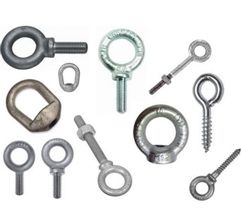 ordinary rusting, making it a good choice for outdoor uses in agricultural, automotive and construction environments. It"s also useful for components such as cogs and springs, where corrosion resistance is also important. Another common grade of stainless steel is type 316, which is considered "marine grade." Type 316 marine grade stainless steel contains molybdenum, which makes it resistant to ocean water mist or spray, so it"s especially useful in extreme conditions or moisture or in a high chloride environment.
ordinary rusting, making it a good choice for outdoor uses in agricultural, automotive and construction environments. It"s also useful for components such as cogs and springs, where corrosion resistance is also important. Another common grade of stainless steel is type 316, which is considered "marine grade." Type 316 marine grade stainless steel contains molybdenum, which makes it resistant to ocean water mist or spray, so it"s especially useful in extreme conditions or moisture or in a high chloride environment.
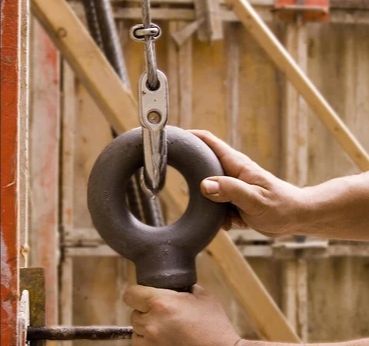
Galvanized metal is a metal that has a thin coating of zinc oxide to protect the steel from elements that lead to corrosion and oxidation. A galvanized eye bolt is also a great value as it tends to be less expensive than a stainless steel eyebolt, but still maintains its strength and durability.
---Eye Bolts vs. Shoulder Bolts
Eye bolt hardware is extremely versatile, but when used for rigging, it should be in vertical techniques only. For angular lifting and loading, a shouldered eye bolt should be used. The shoulder of the eye bolt helps maintain the strength of the eye and the shank from bending or deforming. It's important to remember that loading at an angle will significantly reduce a bolt’s rated capacity. A 75 degree angle reduces the working load limit by 45%; a 60 degree angle reduces it by 65%; a 45 degree angle reduces it by 75%. Never load at an angle less than 45 degrees from the bolt center line.
---What should you avoid when using eye bolts?
• Never force a sling through an eye bolt.
• Never over tighten an eye bolt.
• Never paint or color code an eye bolt. Painting may cover up critical flaws.
• Never force hooks or other fittings into the eye; they must fit freely.
• Never shock load an eye bolt, lifting should be completely slowly and gradually.
• Never use a single eyebolt to lift a load that will rotate freely.
• Never used an eyebolt with signs of wear or any other flaw.
• Never insert a hook in an eye bolt, always use a shackle.
• Never exceed the rated capacity of an eye bolt.
• Never alter an eye bolt. Grinding, machining, stamping or altered it any anyway may compromise the strength and integrity of the eye bolt.